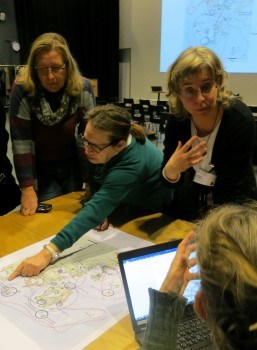Contact
Swedish Centre for Nature Interpretation (SCNI)
Department of Urban and Rural Development, Swedish University of Agricultural Sciences (SLU)
scni@slu.se
www.scni.se

In January two workshops were held in Vasa in Finland and two at the High Coast in Sweden. The title of the workshops was "Which places are important for the World Heritage?"
In order to make it easy for participate for as many as possible at the workshops in January they were at two occasions (afternoon and evening) at each location. It then became four workshops in total in January - two in Vasa and two at the High Coast.
We invited more or less the same actors to these workshops as we had done to the ones in October, which was entrepreneurs, associations, teachers and other active persons. At the workshops in January there were 32 participants in Vasa and 39 at the visitor center naturum Höga kusten at the High Coast.
At these workshops the focus was on specific places in the World Heritage and how they could be highlighted. The discussion was about how the World Heritage in the best way would be presented at the different visitor places in order to reach all the identified visitor groups. In the invitation it said that we at the workshops asked for help to answer the following questions:
As with the previous workshops CNV stood for the main content while the County Administrative Board of Västernorrland and Metsähallitus invited and arranged with the practical details.
To the ones that had registered it was sent out information in advance (see here). The ones that had registered to the workshops at the High Coast also got a map - see the map here.
Each workshop took three hours. We started off with an update of how the work with the project and the heritage interpretation plan had continued since the workshops in October. Then a suggestion for sub themes for the World Heritage was presented and the participants would in groups discuss them. And then we everybody together at the workshop discussed the sub themes. At the workshops in Vasa we then held and exercise where the participants both would discuss how they saw that they could work in the World Heritage with heritage interpretation without being onsite and both got to discuss about hiking trails in the Kvarken Archipelago. At the workshops at the High Coast we instead held an exercise were the participants both got to discuss limitations for different places at the High Coast, i e concerning wear, and both discuss suggestions on dividing areas based on what kind of activity the visitor does at a visit.
We ended every workshop with a group discussion on which heritage interpretation would fit best at some chosen places for chosen visitor groups and to communicate one or two chosen sub themes. The also got to discuss who should produce the heritage interpretation and who should cooperate around those places.
Here is the invitation for the workshops in Vasa och here is the invitation and program for the workshops at the High Coast. Here is the presentation material that was used at the workshops.
The evaluations from the participants showed that:
We that worked with the workshops thought afterwards that:
Swedish Centre for Nature Interpretation (SCNI)
Department of Urban and Rural Development, Swedish University of Agricultural Sciences (SLU)
scni@slu.se
www.scni.se